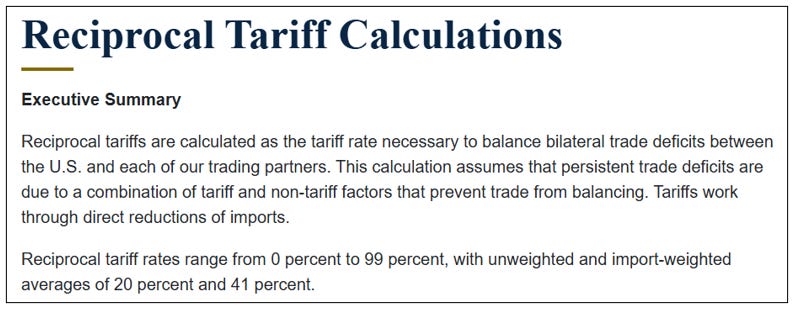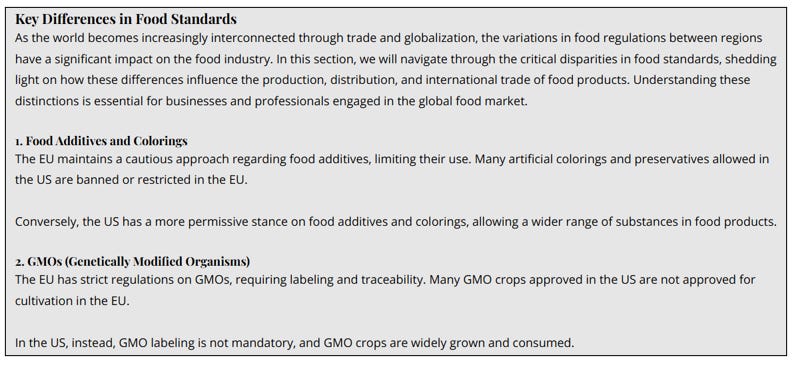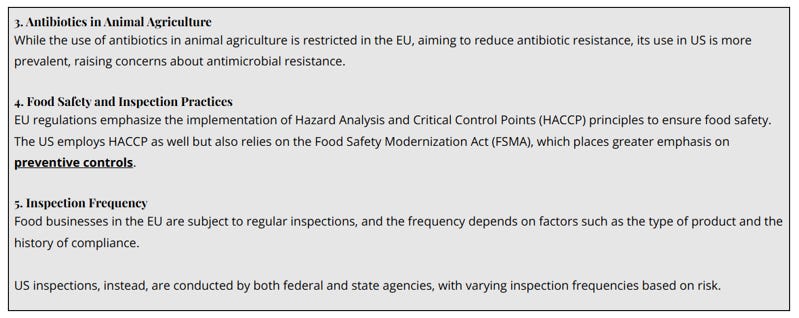How a proper negotiation of "non-tariff barriers" to trade could support MAHA goals.
Should the US improve food standards to EU requirements, or force the EU to lower standards?
During the rollout of the tariffs, many commentators expressed confusion about how the tariff rates were being calculated as they were not necessarily the mirror duplicate of the target country’s rate for US imports. The key language is “non-tariff barriers”.
https://ustr.gov/issue-areas/reciprocal-tariff-calculations
One issue that could improve US food standards is the disparity between United States food regulation and European Union food regulation.
The following information is from a company, RDR Global Partners, that consults companies desiring foreign trade. Screen captures and copied text, with some emphasis added.
https://rdrglobalpartners.com/blog/eu-vs-us-food-regulations-understanding-the-key-differences
European Union (EU) Food Regulations
Stringent Oversight: The EU is known for its stringent food safety standards and regulatory framework. The European Food Safety Authority (EFSA) plays a central role in evaluating and monitoring food safety risks.
Precautionary Principle: The EU adopts a precautionary approach, which means that if a food product's safety is uncertain, it can be banned or restricted until proven safe.
Labeling Requirements: EU regulations demand comprehensive labeling, including clear ingredient lists, allergen information, and nutritional facts. Country of origin labeling is also mandatory.
Pesticide Restrictions: The EU has strict limits on pesticide residues in food products, often more rigorous than those in the US.
United States (US) Food Regulations
In the dynamic world of food regulations, the United States (US) plays a pivotal role with its own set of standards and oversight agencies. US food regulations are governed by a combination of federal and state authorities, making for a complex but adaptable regulatory framework.
Let's uncover the nuances of US food regulations:
FDA and USDA Oversight: Food regulation in the US is primarily overseen by two agencies: the Food and Drug Administration (FDA) and the United States Department of Agriculture (USDA).
Risk-Based Approach: The US typically takes a risk-based approach, allowing products on the market unless there is evidence of harm.
Nutritional Labeling: US regulations require nutritional labeling on packaged foods, but country of origin labeling is generally not mandatory.
GRAS System: The Generally Recognized as Safe (GRAS) system allows food manufacturers to determine the safety of certain food additives without preapproval from the FDA.
Key Differences in Food Standards
As the world becomes increasingly interconnected through trade and globalization, the variations in food regulations between regions have a significant impact on the food industry. In this section, we will navigate through the critical disparities in food standards, shedding light on how these differences influence the production, distribution, and international trade of food products. Understanding these distinctions is essential for businesses and professionals engaged in the global food market.
1. Food Additives and Colorings
The EU maintains a cautious approach regarding food additives, limiting their use. Many artificial colorings and preservatives allowed in the US are banned or restricted in the EU.
Conversely, the US has a more permissive stance on food additives and colorings, allowing a wider range of substances in food products.
2. GMOs (Genetically Modified Organisms)
The EU has strict regulations on GMOs, requiring labeling and traceability. Many GMO crops approved in the US are not approved for cultivation in the EU.
In the US, instead, GMO labeling is not mandatory, and GMO crops are widely grown and consumed.
3. Antibiotics in Animal Agriculture
While the use of antibiotics in animal agriculture is restricted in the EU, aiming to reduce antibiotic resistance, its use in US is more prevalent, raising concerns about antimicrobial resistance.
4. Food Safety and Inspection Practices
EU regulations emphasize the implementation of Hazard Analysis and Critical Control Points (HACCP) principles to ensure food safety. The US employs HACCP as well but also relies on the Food Safety Modernization Act (FSMA), which places greater emphasis on preventive controls.
5. Inspection Frequency
Food businesses in the EU are subject to regular inspections, and the frequency depends on factors such as the type of product and the history of compliance.
US inspections, instead, are conducted by both federal and state agencies, with varying inspection frequencies based on risk.
Conclusion
“The differences between European Union (EU) and United States (US) food regulations are not merely matters of compliance; they encompass the very foundations of food safety, quality, and integrity.”









